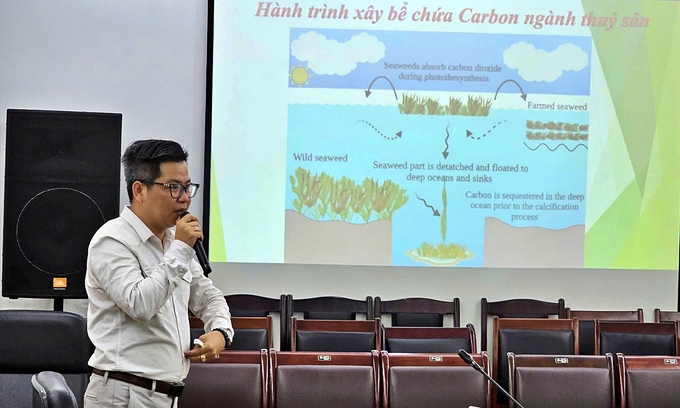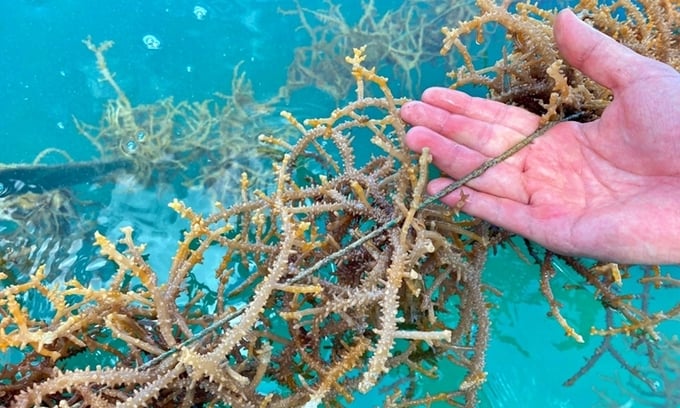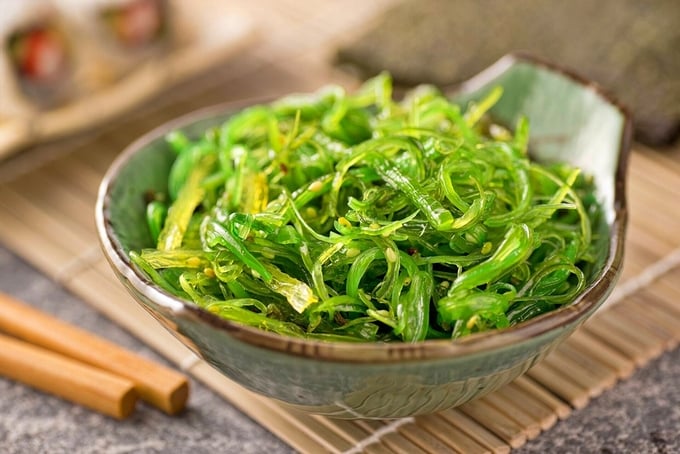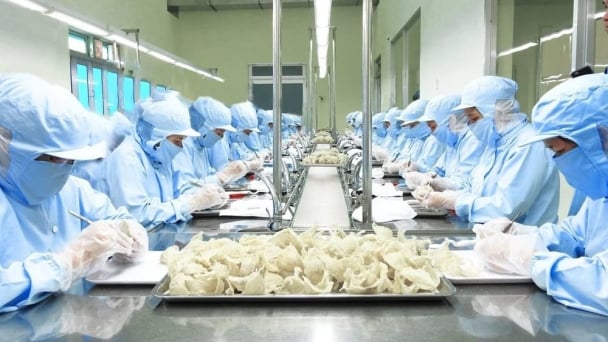May 16, 2025 | 09:48 GMT +7
May 16, 2025 | 09:48 GMT +7
Hotline: 0913.378.918
May 16, 2025 | 09:48 GMT +7
Hotline: 0913.378.918

Mr. Dinh Xuan Lap: "Seaweed farming creates an invaluable carbon sink". Photo: Bao Thang.
For a long time, people have mainly recognized forest plants for their carbon absorption capabilities. However, when considering the same unit area, seaweed can absorb carbon 2 to 5 times more effectively. Notably, some types of seaweed can store carbon up to 20 times more than forest plants.
Compared to forestry development, the seaweed sector has advantages in terms of harvest time and capital turnover for local people. While planting trees like acacia and eucalyptus requires a waiting period of 5 to 7 years for harvest, seaweed can be harvested every 50 to 60 days.
Mr. Tran Dinh Luan, Director General of the Directorate of Fisheries, assessed that seaweed is a multipurpose product. In addition to acting as a carbon sink, seaweed is also very easy to cultivate. In many areas, fishermen have learned to grow seaweed alongside high-value species such as abalone and oysters.
For example, in integrated abalone farming, mixed seaweed serves as the main food source for abalone, allowing farmers to save on feeding costs. Particularly, from December to May, seaweed grows abundantly, almost fully meeting the feeding needs of abalone, and even providing surplus harvest for farmers.
"Seaweed farming requires little effort, and farmers can consider it as labor for profit when combined with other species", Mr. Luan explained, emphasizing that the potential for seaweed is vast. Currently, the country has only about 15.000ha of seaweed farms, producing 135.000 tons of fresh seaweed annually. In the future, the Directorate of Fisheries is advising the Ministry of Agriculture and Rural Development (MARD) to direct localities to expand this area to 900.000ha.
Sharing more about the significance of developing seaweed farming, Director General Tran Dinh Luan said that with the additional income, the livelihoods of fishermen will become more stable, career transitions will be more sustainable and easier to implement.
In line with the overall orientation of the fisheries sector, the Directorate is promoting increased aquaculture while reducing fishing intensity. The involvement of just one or two businesses or organizations cannot change public perception or activate the value chain of the entire industry.
"We are urgently researching to propose a dedicated plan for seaweed, using it as a foundation for people to develop multiple values from seaweed. Beyond its economic aspect, seaweed also has the potential to become a carbon sink or be sold as carbon credits", Mr. Luan emphasized.

The carbon absorption capacity of seaweed is 2 to 5 times higher than that of forest plants. Photo: Bao Thang.
In meetings with international organizations, the Director General of the Directorate of Fisheries acknowledged that they were very surprised to learn about the potential of Vietnamese seaweed. With the advantage of a coastline over 3.000km long and an area of approximately 1 million square km of sea, our country can develop seaweed without needing to invest heavily in feeding. If the farming area is large and stable enough, the potential for emissions reduction from this sector is undeniable.
In the immediate future, the Directorate of Fisheries will collaborate with localities to develop seaweed in several regions with large-scale shellfish farming. Research institutes will also participate in extracting and isolating high-value economic compounds from seaweed. Some seaweed species, such as Caulerpa lentillifera, Kappaphycus alvarezii, Sargassum crassifolium and Ulva reticulata, are highly nutritious and can be cultivated on a large scale, ensuring quality as raw materials for cosmetic and pharmaceutical production.
Additionally, the supporting industry for seaweed, such as developing seaweed ropes or researching specialized strains for livestock feed to reduce methane (CH4) emissions during animal belching, is also being considered. Preliminary studies suggest that seaweed can help improve milk quality in cows.
Recognizing the priceless potential of seaweed, the International Center for Sustainable Aquaculture and Fisheries (ICAFIS) has launched the "Blue Ocean – Blue Foods" program. In addition to promoting and raising community awareness, the program will allocate 10% of the revenue from product lines of partner brands - specifically JapiFoods from Wineco Vietnam Joint Stock Company - to contribute to a seaweed fund for local residents.
“The first task of the program is to increase the area of seaweed farming”, said Deputy Director of ICAFIS, Dinh Xuan Lap. He shared that, with the types of seaweed primarily cultivated in Vietnam’s waters, an average of 1ha of seaweed can store 15 tons of CO2 (equivalent to 15 carbon credits).
With Wineco's involvement alone, the "Blue Ocean - Blue Foods" program aims to expand the seaweed farming area to 1.000ha, which could generate approximately 15.000 carbon credits. If other aquaculture businesses collaborate and regulatory agencies provide interest and support to expand the farming area to 900.000ha (according to the Directorate of Fisheries' orientation), the sector could contribute 13.5 million carbon credits. That is a significant number.

In many countries, seaweed is processed into a variety of dishes. Photo: Bao Thang.
For this reason, ICAFIS has defined the program's focus: “Blue Ocean” aims to enhance CO2 absorption from the ocean, while “Blue Foods” focuses on reducing greenhouse gas emissions in food production, promoting responsible business practices, and creating sustainable livelihoods for coastal fishermen.
The program has been in development for over two years. After conducting surveys and testing various types of seaweed, including farmed Kappaphycus alvarezii in fish cages and oyster farms in the northern, central, and southern regions, the results showed that Kappaphycus alvarezii is the most suitable for integrated farming, contributing to improved ecological conditions.
"Kappaphycus alvarezii and oysters can be considered a perfect duo in aquaculture. Growing Kappaphycus alvarezii alongside oyster farming at sea provides livelihoods for people, especially small-scale fishermen, as the seeds of both species are very cheap. Throughout the farming process, there’s no need to feed or care for them, just monitor until harvest time", Mr. Lap remarked.
In the near future, ICAFIS will intensify research to produce commercialized gel and bioplastic products at reasonable prices, contributing to reducing emissions in line with Vietnam's international commitments.
Vietnam has more than 800 species of seaweed, of which around 90 have economic value. Among them, 20 species contain agar or carrageenan. Mrs. Nguyen Thi Sam, CEO of Wineco, noted that promoting seaweed farming is an effective way to drive the circular economy and reduce the impacts of climate change on coastal communities.
Despite its potential, the seaweed industry faces several challenges, such as insufficient raw materials of the required quality for businesses, a lack of product diversity, and relatively high prices compared to the general market.
One of the reasons seaweed is so effective at absorbing carbon is that around 98% of the sunlight they receive is stored as biomass. Some broad-leaved seaweed species can grow up to 1 meter per day. In some Asian countries, seaweed farming has grown into a multi-billion-dollar industry.
Translated by Phuong Linh

(VAN) Japan's efforts to lower the price of rice through the release of its stockpile may finally be making some progress, albeit at a snail's pace.

(VAN) U.S. tariffs are not only a 'shock', but also an opportunity for Vietnamese businesses to renew their mindset toward comprehensive development.

(VAN) As Bac Giang lychee enters the harvest season, Minister Do Duc Duy expects that the fruit will contribute greatly to agricultural exports due to standardized production and deep processing.

(VAN) Consumers have shown a preference for free-range eggs, but those farming systems are more vulnerable to biosecurity risks like bird flu.
/2025/05/09/5701-1-184335_301.jpg)
(VAN) Vietnam’s eel exports nearly doubled thanks to a mud-free farming model, opening up new prospects while still facing numerous barriers related to international standards.

(VAN) Minister Do Duc Duy warned that if production is not professionalized and supply chains are not transparent, the U.S. market could become a growth bottleneck.

(VAN) Delegating surveillance responsibilities to local authorities is a cost-saving and efficiency-boosting measure that removes a key bottleneck for enterprises, according to Director General Duong Tat Thang.